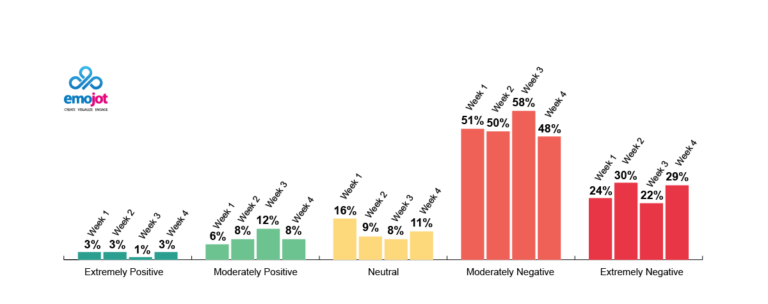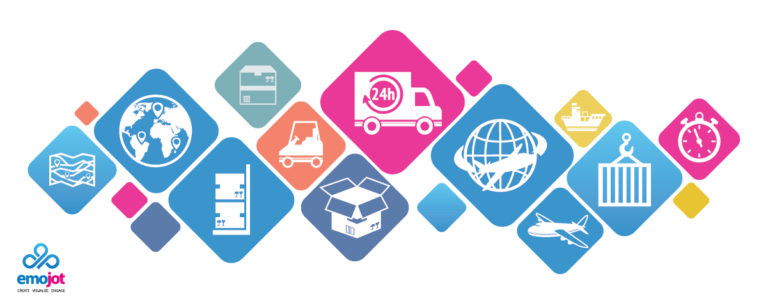
The Covid-19 crisis has upended life as we knew it. Preparing for a “new normal”, one of USA’s largest automobile manufacturers, Fiat Chrysler Automobiles (FCA), has started to re-imagine the vehicle selling process. FCA is headquartered in Detroit, Michigan, and has more than 2600 dealerships across the United States. FCA has a culture of engaging with their dealership stakeholders in order to understand their on-the-ground realities when making strategic decisions. As the Covid-19 crisis forced businesses across the United States to shutter up, FCA has started to explore how they could adapt their vehicle selling processes in the “new normal” to cater to Americans emerging from their shelter-at-home period. Amongst the strategies they are considering are how they could systemize remote new vehicle delivery options for sales and test drives. FCA has been using the Emojot platform to regularly and effectively engage with their dealership network stakeholders who are at the frontline of selling and delivering vehicles, parts, and services, for the Alfa Romeo, Chrysler, Dodge, Jeep, Fiat, Ram, and Maserati brands. When FCA needed to get quick feedback on remote vehicle delivery and test drive scheduling software options for their post-Covid19 planning, they turned to Emojot to rapidly deploy a 2-minute visual survey. Emojot deployed the campaign for FCA in less than 6 hours. The geo-map below shows the coverage density of the survey respondents from FCA dealerships who responded while “working from home”. Emojot’s Emotion Sensors™ have consistently received high response rates amongst FCA dealership stakeholders, and this campaign which was launched in the midst of the Covid-19 crisis followed the same trend, both in terms of quantitative question responses as well as qualitative comments. Since Emojot’s Emotion Sensors™ have intelligence on the front end, we are able to provide FCA with the added insight on role segmentation, and […]

Data-driven insight is powerful, particularly in a crisis! People, businesses, and governments around the world are dealing with the paralyzing effect caused by the Covid-19 pandemic. These effects manifest and change daily! In such a significantly changing landscape, the need to understand the substantial impact of the crisis on companies is very important. The strategies and critical decisions that businesses adopt to deal with the impact on their corporate financial ‘health’ inevitably have an effect on the larger state and country economies. The San Francisco Bay Area’s Alliance of Chief Executives have weathered through 2 other major crises in their 24-year history – the 2000 dot.com crash and the 2008 world financial crisis. But now they face possibly the most serious crisis! According to Paul Witkay, the Founder and CEO of the Alliance of CEOs, “Although no one enjoys these crises, my experience has been that times like these force CEOs to think more creatively and generate more counter-intuitive strategies.” In classic Silicon Valley-style, the Alliance of CEOs swung into action in mid-March, by deciding to launch a weekly business sentiment trend analysis with a 1-minute CEO Business Trends Survey. The results are published within 24 to 36 hours of deployment, every week. Their objective is to leverage this weekly trend analysis of how Bay Area CEOs are experiencing the COVID-19 crisis to help them all plan more effectively and make better decisions. Additionally, the survey engagement was designed to provide an easy way to let the CEO Alliance leadership know if their company executives had any questions or challenges that might be helped by someone else in the Alliance community of CEOs. How has your business changed during the pandemic?[emojot type = “button” size=”small” key=”5770bdd408a69b2050a9764f” id=”5770bba70409e08c75a46b04_5ecf8361bcf5270010920cf1″ clientid=”TxflwzfAaMujFELGh_egokuaUnAa” clientsecret=”db6b2R0xXbw9dgU9Ig7pHfh6AMoa”] The CEO Alliance uses the Emojot platform, to efficiently deploy these […]

Climate change is a critical global problem, and Emojot’s Emotion Sensor™ aims to raise public awareness about it. To make the quiz more engaging, we have introduced captivating GIF backgrounds that serve as themes. These visually appealing skins infuse the Emojot’s Emotion Sensor™ with personality and charm, delivering an immersive experience for users and increasing their enjoyment. Additionally, the survey utilizes advanced analytics such as the pulse meter and geo map, providing valuable insights. To foster in-depth feedback and specific suggestions, the survey also includes comment fields, encouraging customers to share their detailed opinions. Want to explore more? Share your details to schedule a personalized demo with one of our product experts and experience our solution in action!

Having a restaurant doesn’t boil down to providing appetizing food but also providing a great service to your guests – it’s all about creating a customer experience that will generate repeat business for you in the long run. With an influx of technological advancements, modern dining has transformed into a new paradox of acting far beyond the physical experience. The use of mobile apps has begun driving everything from ordering, tracking, delivery, pick-up and opinion-sharing too. This shift puts your guests in the driver’s seat and your success is dependent on how you can maintain consistent customer engagement to create a long-lasting emotional connection with them. According to Deloitte’s restaurant customer experience survey, 60% of guests said a positive experience will cause them to dine at the restaurant more frequently. So, it pretty much depends on having a feasible customer experience strategy. A strategy that would yield beneficial results to your customers and the growth of your restaurant as well. Do you think creating a positive experience will make guests dine more at the restaurant? As a restaurant owner, you should primarily think of what your guests truly want. And, we know this can be a challenging task with an influx of guests visiting your restaurant day in and day out. But it is important to action upon this. With the basis of restaurant competition evolving during this day and age, it is important to hear your customers out and drive factors that help in achieving your restaurant’s mission – menu, taste, price, convenience, staff and safety. And that too by using a user-friendly method that can engage your guests in real-time and generate information. Information that would empower you to initiate best decision-making practices. This gold-mine of information is what we refer to as data. Data that can be […]

Employee engagement happens to be one of the buzz words in today’s corporate world. But do people really understand what it means? I don’t know for sure but, one thing I know is that it is one of the most interesting yet tough to attain aspects in management. Organizations are definitely starting to realize the importance and need for a happier and engaged workplace with the rising number of millennials entering the workforce. Well, It makes sense as to why there is so much hype about engaging employees at the workplace as according to the Bureau of National Affairs, US businesses lose $11 billion annually as a result of employee turnover. And Among the 1,500 employees, only 29% are fully engaged and 26% are disengaged. Almost half (45%) are partially engaged. There are many aspects that make an organization successful. Cutting edge products and services, innovative strategies, new technologies etc but there is one thing that overpowers all of these factors and goes on to create long-lasting competitive advantage which in return impacts ROI. That is undoubtedly the employees of an organization. Employees are the heart of an organization and many research studies have proven that there is a direct positive correlation between organizational performance and engaged employees. As Andrew Carnegie very correctly pointed out “You must capture the heart of a supremely able man before his brain can do its best.” I personally like to define employee engagement as the emotional commitment an employee has towards their organization and its goals. There are tons of ways in which an organization can engage their employees, but it’s important to find the right techniques which go in line with your organizational culture. Here are 10 tips that may help engage your employees better, this is based on the Ten C’s model […]

No business can function without its customers. Your clientele are the cornerstone of your company. Their satisfaction makes or breaks your profits, brand, reputation, and, ultimately, survival as an enterprise. You probably already realize that communicating effectively with your clients and fully understanding their feedback is a vital part of keeping your company thriving, but how can you go about this? Most customers never share their opinions with companies, and those who do tend to be either enthusiastically happy or (unfortunately more often) absolutely exasperated. Of course, you can attempt to send out a lengthy email questionnaire or badger your clients to answer “just a few questions” over the phone, but only a small percentage of your consumer base is likely to take these surveys very seriously. The solution to your customer satisfaction conundrum does, in fact, exist, but you may not have yet encountered this emerging technology. Perhaps you’ve heard the term “voice of customer” bandied about at conferences or in advertisements, but do you know what this actually means? As it goes with many great advances, many businesses don’t yet understand the value of “voice of consumer” tools, or even know what these burgeoning applications are, but they soon will. Becoming an early adopter in this area could have a serious impact on your company’s future. At Emojot, we use “voice of consumer,” or VOC technology to help our clients flourish in this twenty-first century business atmosphere. In the following blog, we define this term and explain why your customers’ feelings matter so much to your enterprise. Vital Components of VOC Before we expound any further on the benefits of VOC, we should first fully describe what it is. Business Dictionary defines it as “collective insight into customer needs, wants, perceptions, and preferences gained through direct and indirect […]

With the rapid growth of technologies, our lives continue to change extensively. Research has pointed out that technology adoption is the most powerful tool for organizations to maintain their competitive edge. The survival of an organization in the age of an evolving knowledge-based economy depends on how they improve their technological capabilities, across all business operations. Keeping this focus area in mind, organizations should develop and implement sufficient methodologies and modern technologies in the logistics field and integrate collaborative logistics processes to be even more competitive. A growing number of logistics organizations are pressurized to change their traditional management style – operationally and organizationally – to a more robust, integrated system that will help increase speed of information flow for rapid decision-making practices. To reach this goal, organizations should invest on new information and communication technologies. Essentially, the type of technologies that would provide vital information such as customer feedback/customer sentiment at their fingertips. The type of information that would help them understand customer satisfaction levels with the services they provide. This information can certainly be generated by a simple, yet effective customer engagement platform. A solution that follows an effective customer engagement process that would primarily act as the voice of your customers – across all your logistics business operations. And most importantly a solution that uses something as simple as an ‘Emotion Sensors™’ that can be used across all digital platforms – be it a Kiosk, Email, Whatsapp, Viber etc. Wouldn’t it be thrilling to know how your customers felt about the efficiency of your services? Or, wouldn’t it be even more thrilling to understand which of your services require improvements, and that too straight from the horse’s mouth? We know that Emojot’ voice of customer solution not only has the ability to translate into an effective customer […]







